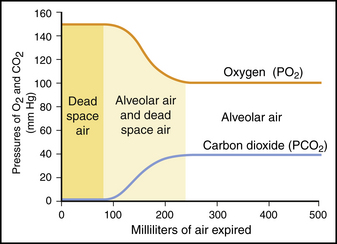34 CASE 34
PATHOPHYSIOLOGY OF KEY SYMPTOMS
The initiating event is the arterial hypoxia caused by the decline in inspired O2 due to the drop in barometric pressure. At 14,000 ft, inspired air has a PO2 of approximately 93 mm Hg and alveolar air has a PO2 of around 55 mm Hg (Table 34-1).
TABLE 34–1 Effects of Acute Exposure to Low Atmospheric Pressures on Alveolar Gas Concentrations and Arterial Oxygen Saturation∗

An end-tidal gas measurement indicates that the alveolar PO2 in this patient is 60 mm Hg. Arterial blood gas values will be even lower because of venous admixture. This level of hypoxia is sufficient to stimulate the arterial chemoreceptors and cause an increase in ventilation. Hyperventilation leads to a drop in CO2 levels, and the patient will have a mild respiratory alkalosis. The hypocapnia removes some of the normal respiratory drive from CO2, and the increase in ventilation is attenuated but remains elevated compared with sea level (Fig. 34-1).

FIGURE 34–1 Partial pressures of oxygen and carbon dioxide in the various portions of normal expired air.
Stay updated, free articles. Join our Telegram channel

Full access? Get Clinical Tree


